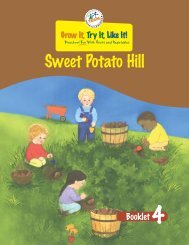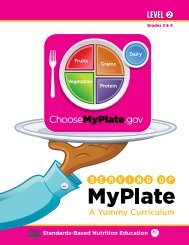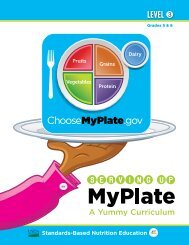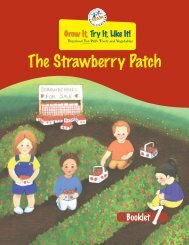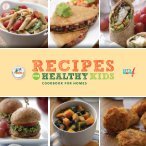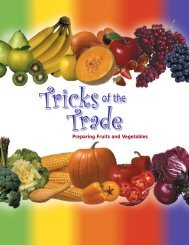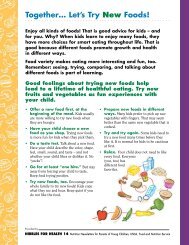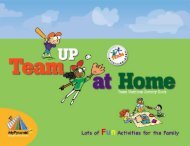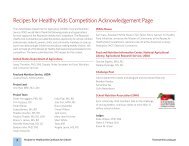Serving Up MyPlate-A Yummy Curriculum, Level 1 - Team Nutrition ...
Serving Up MyPlate-A Yummy Curriculum, Level 1 - Team Nutrition ...
Serving Up MyPlate-A Yummy Curriculum, Level 1 - Team Nutrition ...
You also want an ePaper? Increase the reach of your titles
YUMPU automatically turns print PDFs into web optimized ePapers that Google loves.
Part B: Solid Fats (30 minutes)<br />
10. Show the class a sample of butter and a sample<br />
of vegetable oil. Ask if anyone knows what types<br />
of foods butter and vegetable oil are. (They are<br />
fats.) Ask for volunteers to describe the difference<br />
between the butter and the oil. (The important<br />
difference is that the butter is a solid and the<br />
oil is a liquid.) Can any students describe the<br />
characteristics of a solid and characteristics of a<br />
liquid? We call butter a solid fat and vegetable oil a<br />
liquid fat. Solid fats, like butter and stick margarine,<br />
are solid at room temperature. Liquid fats, like olive<br />
oil or canola oil, are liquid at room temperature.<br />
11. Ask if anyone knows why we might want to think about<br />
the types of fats that we eat. Accept all answers.<br />
12. Divide the class into small groups and set them<br />
up at different stations. Each station will have a<br />
sample of butter (2 Tbsp in a dish), a sample of<br />
vegetable oil (2 Tbsp in a dish), and enough straws<br />
for everyone in the group. Have the students put<br />
one end of the straw in the vegetable oil. Ask them<br />
to share what they observe when they pull out the<br />
straw. What do they notice? (The oil drains out<br />
of the straw. It does not clog up the straw.) Give<br />
students a chance to dip the straw in and out of the<br />
oil and watch what happens to the oil when they do<br />
this.<br />
13. Now have them put the other end of the straw into<br />
the butter and then observe what happens when<br />
they pull out the straw. What do they notice? (The<br />
butter clogs up the end of the straw.)<br />
14. Explain that liquid fats are healthier for our hearts<br />
than solid fats. Explain that our hearts pump blood<br />
through our bodies using little tubes (like straws)<br />
called arteries and veins that carry blood to the rest<br />
of our body parts. We need our heart and these<br />
tubes to be healthy so that our body functions well.<br />
15. Ask students if they can think of any foods that have<br />
solid fats in them, and are therefore “sometimes”<br />
foods. Possible examples include:<br />
• Hot dogs<br />
• Sausage<br />
• Bacon<br />
• Fried chicken<br />
• Doughnuts<br />
• French fries (fried in solid fat)<br />
16. Ask volunteers to explain why it would be smart for<br />
people to not eat too many foods with solid fats in<br />
them. (These foods make it harder on our hearts.<br />
And they can fill us up before we get what we need<br />
from other healthy foods.)<br />
DIGESTING IT ALL: Explain, Evaluate<br />
(40 minutes)<br />
TEACHER’S<br />
Morsel<br />
17. Summarize and reflect on the lesson by asking the<br />
class the Essential Question: “What foods should I<br />
eat less of and why?” Invite students to share what<br />
they have learned. Remind students that foods and<br />
beverages with added sugars and solid fats can fill us<br />
up and not leave room for foods we need to eat to<br />
get nutrients.<br />
18. Divide the class into pairs and pass out the handout<br />
“Sometimes” Foods and “Switcheroos” to each pair.<br />
Explain to students that in this activity they will look<br />
at five food examples that are high in added sugars<br />
or solid fats, known as “sometimes” foods and work<br />
together to come up with healthier alternatives, or<br />
“Switcheroos.”<br />
19. After the students have had 10 – 15 minutes to<br />
discuss and complete the handout, regroup to<br />
allow them to share their answers with the class.<br />
Write the names of each food group as headings<br />
on the board. (There should be a “Fruits” heading, a<br />
“Vegetables” heading, etc.)<br />
21<br />
<strong>Serving</strong> <strong>Up</strong> <strong>MyPlate</strong> — Grades 1 & 2 http://teamnutrition.usda.gov<br />
U.S. Department of Agriculture • Food and <strong>Nutrition</strong> Service • September 2012 • FNS-444



